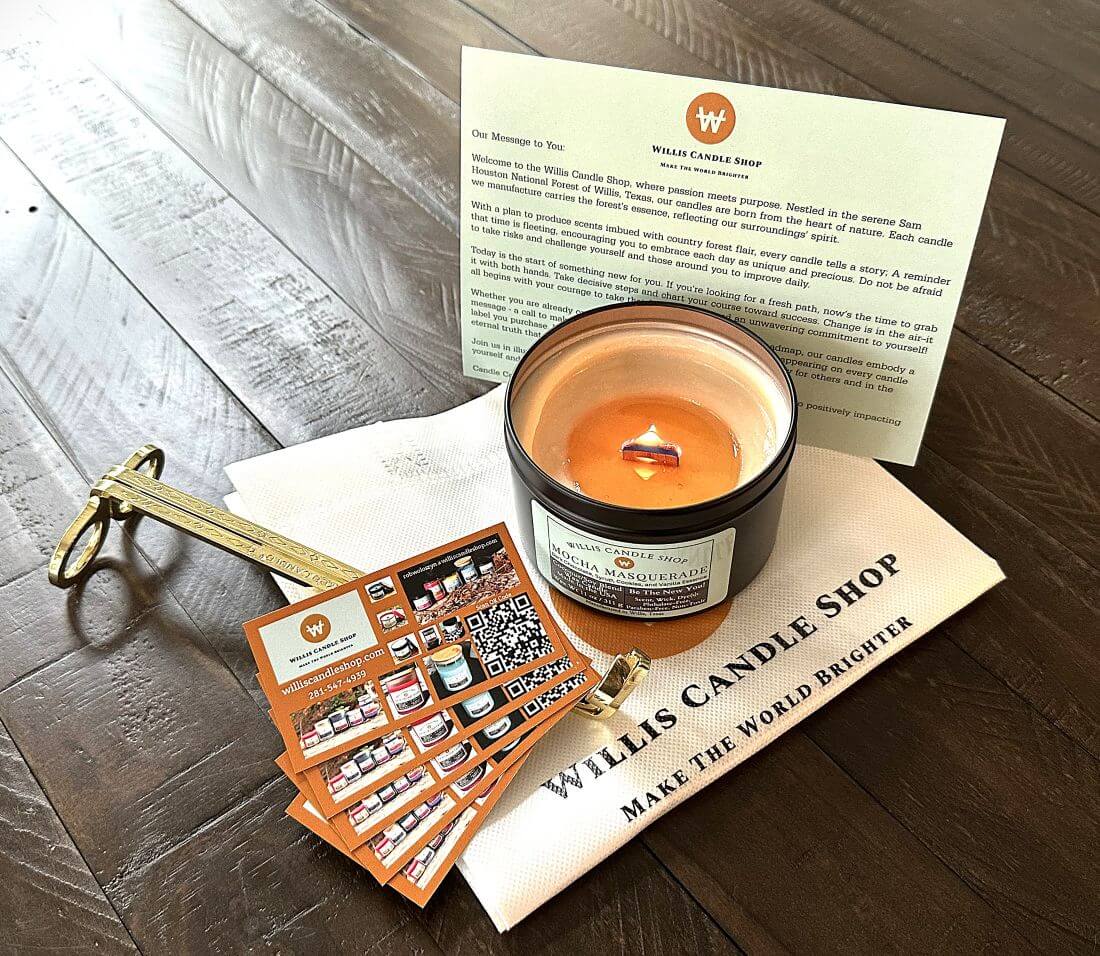
Candle Care Science | Wick Tips and Even Melts
The Biggest Candle Mistake: Drafts and Airflow
Every candle lover wants an even burn and a strong, steady flame, but few realize just how much drafts and airflow can sabotage the experience. Whether it’s an overhead air conditioning vent, a ceiling fan, or just a breeze from a nearby window, moving air will tilt the flame toward one side of your scented candles or wood wick candles. This causes uneven wax melting, leaves store candles with thick wax along the sides, and often creates candle tunneling that’s hard to fix later. At Willis Candle Shop, we see this mistake every week. If your only option is a drafty spot, you must rotate your coconut soy candles about 90° every hour to ensure the heat melts all sides evenly. It’s a simple step that keeps your candles on sale burning their best and extends the life of every masculine candles favorite in your home.

Rotating Candles in Breezy Spaces: The Simple Fix
If you’re stuck burning candles under an air vent or near a fan, don’t stress—rotation is your friend. By turning the vessel 90° about every hour, you guarantee the flame spends equal time melting each side of the wax. This keeps candle wax not melting evenly from becoming a real problem and prevents tunneling before it starts. It’s especially critical with wood wick candle care and proper candle burning practices, as uneven wax can choke out even the best candle company blends. For more on unique candle stories and tips, check out how Willis Candle Shop was featured in AP News. This small habit is a game-changer for those committed to candle care excellence and keeps your best candle tips in play for years to come.
Wooden Wick Science: How to Light and Maintain Them
Lighting a wooden wick is not like lighting a traditional cotton wick. Use a long-reach butane or utility lighter—hold the flame on the entire surface for at least five seconds, making sure all sides catch. This is crucial for wood wick candles, since their burn relies on vaporized wax and fragrance, not the wood itself. Before each burn, let the candle cool completely—ideally overnight—then use your fingers to gently snap off any charred wood (about 1/16 to 1/8 inch). Never try to cut the wick too low; just break off the loose char and toss it in the trash (never hot embers). If you’re serious about wooden wick troubleshooting or want to dive deeper, check out these handmade gift candle insights to learn more about what makes wooden wicks different from cotton. Mastering this step is key to how to burn candles safely and cleanly, with less smoke and a longer-lasting flame.
Why Wick Trimming Matters—And How to Do It Safely
Wick trimming is essential, whether you’re using best wood wicks or cotton wicks. For cotton wicks, always keep the tip at 1/4 inch—too long and you risk mushrooming, too short and the wick may drown in wax. The Premier 700 series we use at Willis Candle Shop has a natural curl that helps regulate burn and prevent excessive soot. Just pinch off the char when the candle is cold; never trim with scissors too close to the wax, or you might make the wick too short to burn. For more inspiration, explore our 12oz glass candle—a customer favorite for clean, even burns. Keeping wicks maintained is part of candle maintenance and how to trim candle wick like a pro.
Understanding Wood Wick Embering: It’s Not a Flaw
Wooden wicks have a mind of their own—sometimes they burn with a tall, visible flame, and other times they simply “ember” with a glow across the top. Both are normal. A lower, ember-like flame actually makes how to make candle last longer a reality, giving you more hours from every vessel. The downside is that a low flame may take longer to reach a full wax melt pool, increasing the risk of candle not burning evenly or causing fix candle tunneling to be needed later. If your wick embers, don’t panic—it’s often a sign of an efficient burn. If you want to learn more about what goes into our coconut soy blend and how it affects the burn, see coconut soy candle benefits. Just remember, patience pays off: allow a full melt pool whenever you can.
Cotton Wick Curl Explained: Premier 700 Series Secrets
The curling tip you see on the Premier 700 series cotton wicks is intentional and comes from how these wicks are manufactured by their original suppliers—not Willis Candle Shop or Black Tie Barn. This curl helps slow down the burn and prevent excess fuel draw, which means fewer issues with candle flame too low or why is my candle smoking. It also helps the flame lean slightly, so if you’re burning in a drafty area, rotate the candle every hour to avoid wax build-up on one side. For more about cotton wicks and their natural quirks, learn about Black Tie Barn, our trusted supplier. This simple tip can help with candle burning tips and wood wick vs cotton wick decisions for any serious candle lover.
Wooden Wick Choices: Explore Makesy Wooden Wicks
At Willis Candle Shop, all our wooden wicks come from the Ultimate Wood Wick series available at Makesy. We choose these wicks for their unique burn characteristics and reliable performance. If you want to know more about wood wick options and proper care, explore Makesy wooden wicks and see why so many premium candles use them. Whether you’re new to wooden wick care or a seasoned candle collector, knowing your wick source makes a difference in performance and longevity. Each batch is tested for best way to burn candles and why candle wick burns out—so you get consistent, top-quality results every time.
Pro Tips for a Perfect Burn Every Time
To sum up: always burn your candle long enough to achieve a full melt pool—usually two to three hours for standard vessels. Rotate regularly if there’s any airflow, and don’t light if you can’t commit to a full, even melt. Trim wicks only when cold, and avoid over-trimming, especially with cotton. If you ever trim a wick too short and it drowns, carefully remove wax with a toothpick and try again. These tips apply to every style—whether you’re using soy candle care routines, fixing candle wick not staying lit, or just trying to how to prevent candle tunneling. The more you practice proper candle care, the better results you’ll see with every new addition to your collection.
FAQs
How often should I rotate my candle in a drafty room?
Every hour, rotate the vessel 90° to keep the flame melting all sides of the wax evenly and prevent tunneling.
What’s the best way to trim my wick for a clean burn?
Wait until the candle is fully cool, then pinch off the char at the tip of the wick. Don’t trim too close or you risk drowning the wick.
Why do some wood wicks only glow, not burn with a tall flame?
A low ember is a normal, efficient burn and will help your candle last longer. It just may take longer to reach a full melt pool.
The information presented in this blog post is for general educational and informational purposes only. While Willis Candle Shop aims to provide accurate and up-to-date details, the content may not reflect the latest changes in our products, policies, or practices. Nothing in this blog constitutes legal, medical, or professional advice.












